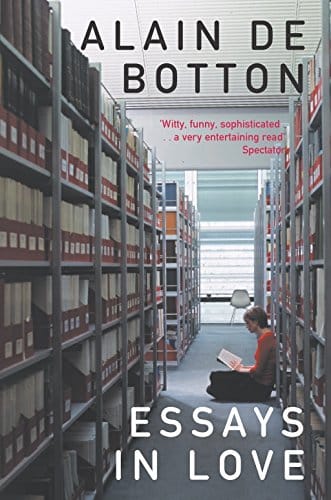Essays in Love: Alain de Botton’s Timeless Guide to Modern Relationships
Explore the main ideas and relationship insights in Alain de Botton's Essays in Love, with a concise summary, themes, quotes, and practical takeaways.

Introduction to Essays in Love
When Alain de Botton published Essays in Love in 1993, the Franco-Swiss philosopher was only twenty-three. Decades later the novel-length essay remains a cult classic, partly because it marries narrative drive with razor-sharp reflection. The unnamed narrator falls in and out of love with a woman named Chloe, but what matters is not the plot twist; it is the microscope de Botton places over every glance, hope, fear and rationalization that love sets in motion. The result is a book that doubles as both romantic chronicle and philosophical field guide.
Plot Overview in Brief
Like most relationships, the story begins on an airplane, moves quickly to dinner dates and shared jokes, peaks with declarations of eternal devotion, and then stumbles through miscommunication toward heartbreak. De Botton structures each stage of the affair—anticipation, idealization, doubts, jealousy, breakup—into numbered essays that read like a laboratory log. This deliberate scaffolding is important because the author’s mission is analytical: he wants to show that passion obeys patterns, even when we swear our emotions are unique and indefinable. The concise plot therefore functions as a mirror in which readers recognize their own romantic histories.
Core Themes Worth Revisiting
The Philosophy of Everyday Romance
De Botton argues that Western culture trained us to treat love as salvation. We expect partnerships to answer our existential questions, make us permanently happy, and fend off loneliness forever. By dismantling these myths one anecdote at a time, he shows that relationships are better framed as collaborative projects marked by imperfection and negotiation. The philosophical takeaway is liberating: once love is stripped of its metaphysical aura, ordinary compromises no longer feel like failures but like evidence that two people are doing real human work together.
The Psychology of Projection
Another major theme is projection—the tendency to credit the beloved with traits we crave rather than traits they actually possess. Early scenes in the book show the narrator praising Chloe’s "moral seriousness" because she orders a green salad. Later he blames her for lacking that very seriousness when she turns down a museum trip. De Botton uses these contradictions to illustrate how lovers often write fiction onto each other, only to become resentful when reality refuses to comply. Understanding projection, he suggests, is the first step toward a kinder, more accurate form of intimacy.
The Necessity of Melancholy
While many self-help books glorify positive thinking, Essays in Love dignifies sadness. After the breakup, the narrator wanders London cataloging the colors of his despair; yet even in that darkness he finds meaning, noting that heartbreak returns us to ourselves and forces a re-examination of values. De Botton therefore reframes melancholy not as a detour on the road to happiness but as an essential stretch of the journey. Readers who are currently nursing heartache often find these passages especially consoling.
Memorable Quotes and Why They Matter
De Botton’s sentences stick because they unite clinical clarity with emotional resonance. Consider: "Every fall into love involves the triumph of hope over self-knowledge." The line captures both the optimism and the self-deception required to open one’s heart. Another favorite: "We call it 'falling' in love because we cannot control where we land." This metaphor undermines the modern myth that we select partners through pure rational agency. Sprinkling such quotable insights throughout the book not only elevates its literary appeal but also makes it endlessly shareable on social media, a fact that helps the title remain relevant in the digital age.
Lessons Modern Couples Can Apply
First, practice descriptive rather than evaluative communication. Instead of labeling a partner "inconsiderate," describe the specific action that hurt you, echoing de Botton’s plea for linguistic precision. Second, schedule regular "reality checks" to test assumptions and defuse projection before it metastasizes into resentment. Third, normalize emotional downturns: relationships are cyclical, and a temporary dip does not always portend doom. These practices convert the book’s philosophical reflections into pragmatic tools for anyone navigating Tinder dates or twenty-year marriages alike.
Why the Book Still Resonates Today
In an era of algorithmic matchmaking, ghosting, and curated online personas, Essays in Love offers an antidote to superficial connection. Its slow, reflective pace encourages readers to linger over feelings that apps usually reduce to swipes. Moreover, the book’s cross-disciplinary approach—mixing literature, psychology, anthropology and theology—prefigures the current boom in "hybrid" nonfiction. Millennials and Gen Z readers, hungry for frameworks that make sense of chaotic dating landscapes, therefore find the text unexpectedly prescient.
Final Thoughts
Calling Essays in Love a mere love story undersells its ambition. It is a philosophical operating manual, a psychological case study, and a quietly hopeful manifesto that insists growth is possible even after romantic ruin. Whether you are blissfully coupled, cautiously single, or nursing fresh wounds, de Botton’s book hands you a vocabulary to articulate what so often feels inexpressible. That enduring gift explains why, thirty years on, readers still underline its passages, recommend it to friends, and return to its pages whenever love next surprises them.



